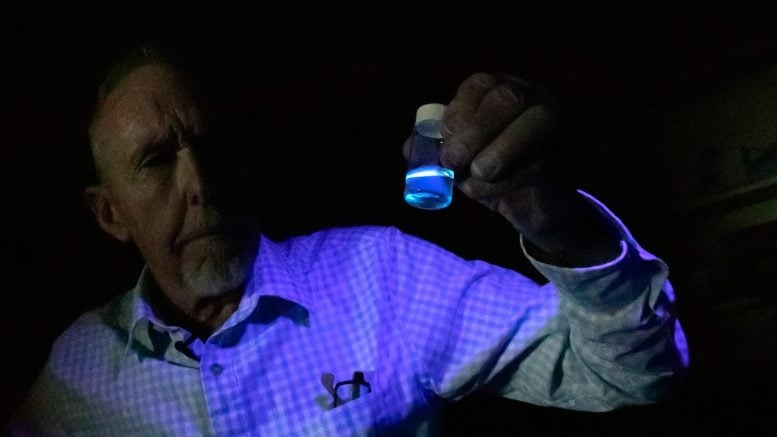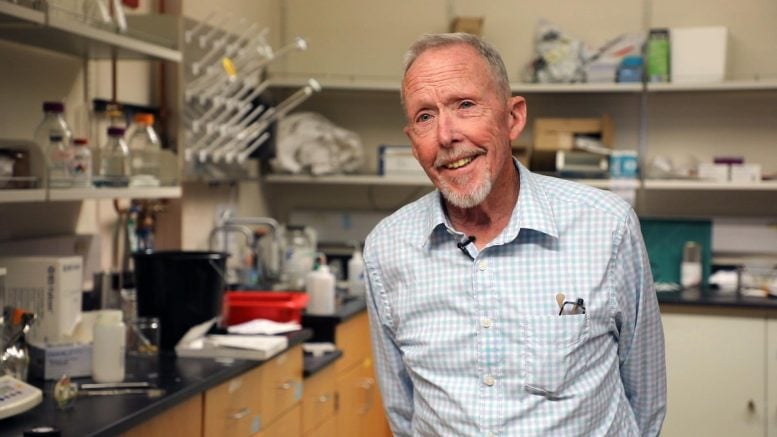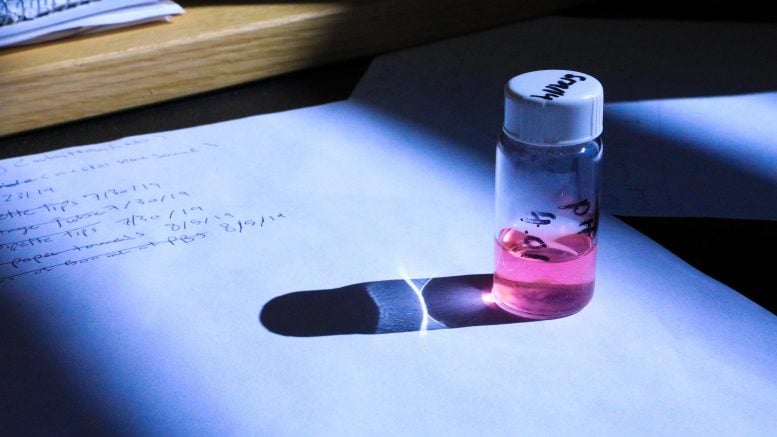
As the deadly COVID-19 pandemic continues to wreak havoc around the world with no end in sight, new ways in which to stop the spread or mitigate the effects of the disease are few.
Although most experts agree that a vaccine would significantly slow or eventually stop the spread, the work to develop, approve and distribute such a vaccine are likely months away. That leaves us with only prevention efforts such as masks, social distancing and disinfecting, which partially due to human inconsistencies in behavior, have proven to be variable in effectiveness.
Despite these grim realities about the novel coronavirus that has taken 2020 by storm, disrupting the work, school and personal lives of nearly everyone on the globe, some University of New Mexico researchers have found a possible breakthrough in how to manage this virus, as well as future ones.
A team led by the Center for Biomedical Engineering faculty David Whitten, Distinguished Professor in the Department of Chemical and Biological Engineering, along with Eva Chi and Linnea Ista, faculty members in the same department, have found some light at the end of the tunnel, so to speak.
The main finding of their research, highlighted in the paper, “Highly Effective Inactivation of SARS-CoV-2 by Conjugated Polymers and Oligomers,” published this week in the journal ACS Applied Materials & Interfaces, involves the ability of the combination of certain polymers and oligomers, when combined with UV light, to almost completely kill the coronavirus.
UNM co-authors on the paper were Florencia A. Monge, of UNM’s Center for Biomedical Engineering and the biomedical engineering graduate program; Virginie Bondu of the Department of Molecular Genetics and Microbiology at the UNM School of Medicine; Alison M. Kell, Department of Molecular Genetics and Microbiology at the UNM School of Medicine; and Patrick L. Donabedian of the nanoscience and microsystems engineering graduate program at UNM. Also on the team are Kirk S. Schanze and Pradeepkumar Jagadesan, both of the Department of Chemistry at the University of Texas at San Antonio.

Although disinfectants such as bleach or alcohol are effective against the virus, they are volatile and corrosive, which limit lasting sterilization of surfaces treated by these products, Whitten said.
What is different about these polymer and oligomer materials is that when activated with UV light, they provide a coating that is shown to be fast acting and highly effective, reducing the concentration of the virus by five orders of magnitude, Chi said.
“These materials have shown to have broad-spectrum antiviral properties,” she said.
Whitten points out that in order for the material to be active against the virus, it must be exposed to light. Light activates the “docking” process that is important and necessary for placing the oligomer or polymer at the surface of the virus particle, allowing the absorption of light that generates the reactive oxygen intermediate at the surface of the virus particle.
“As far as we know so far, materials such as ours are not active against SARS-CoV-2 in the dark and require activation by irradiation with ultraviolet or visible light, depending on where the specific antimicrobial absorbs light,” he said. “In the dark, our antimicrobial materials ‘dock’ with the virus, and then on irradiation, they activate oxygen. It is this active, excited state of oxygen that starts the chain of reactions that inactivate the virus.”

And this science can easily be applied into consumer, commercial and healthcare products, such as wipes, sprays, clothing, paint, personal protective equipment (PPE) for healthcare workers, and really almost any surface.
“When incorporated into N95 masks, this material works well against the virus,” Chi said. “In addition to trapping the virus in a mask, this would make for better PPE and prolong its life.”
Another unique advantage of this material is that unlike traditional disinfectant products, it is shown to not wash away with water and leaves no toxic residue as a result of the photodegradation process, Chi said.
Studying the potential of conjugated polymers and oligomers is nothing new for UNM researchers. In fact, Whitten and another of the authors on the study, Kirk Schanze, have been researching this area for a couple of decades.
Whitten and Chi said colleagues such as Schanze and others have collected a lot of data on polymer and oligomers, so when the pandemic hit in the spring, Whitten almost immediately started wondering how his area of study could help.
“It was the right timing for all of us,” Chi said.
Acquiring live coronavirus for research is not an easy feat, but thanks to the efforts a couple of team members, they were able to make it happen.
Linnea Ista is a member of the Biosafety Committee at UNM, and when the pandemic broke out and she was aware of the research that Whitten and Chi were conducting, she realized that she may have a connection on how to make the research happen, due to the fact that representatives from UNM’s School of Medicine also sit on the committee.
Alison Kell, a faculty member in the School of Medicine, was the one who was able to acquire the live coronavirus for testing the effectiveness of these materials. She has been working with the SARS-CoV-2 virus in her research and was able to develop a protocol for analyzing samples the team prepared and exposing them to near UV or visible light.
Due to the sensitive nature of working with a virus such as coronavirus, it was crucial for Kell to be part of the team, since the work had to be done in cooperation with the UNM School of Medicine, which has BSL-3 lab facilities that are essential to doing study on the highly-contagious active virus, Ista said.
Whitten said he is hopeful that this discovery can quickly be put into use. He has a company called BioSafe Defenses that he said has hired a former Environmental Protection Agency official to help expedite the regulatory process in taking this discovery to market. He anticipates that once a material is approved, it will be only a matter of months before wipes, masks, and other products are in the marketplace.
He said their research has found that adding the material into wipes would add only pennies per wipe. Additionally, the material could be added into masks and other personal protective equipment, changing the game for businesses such as gyms, airlines, cruise ships, groceries, health care facilities, schools, and many more industries. In addition to coronavirus, these products could also help eliminate infections by the common cold, seasonal flu, and other viral and bacterial infections that plague millions of people annually, causing loss of work and school time.
“There is a limitless market for this,” he said.
He added that the current pandemic is likely not the last such public health crisis we will see, so even after a vaccine for coronavirus is available, such products could be useful in combatting a wide variety of viruses and bacteria, including the flu or common cold.
“We’re not just thinking about COVID but other pathogens and any viral agents,” Whitten said. “We want to be ready for the next pandemic.”
Reference: “Highly Effective Inactivation of SARS-CoV-2 by Conjugated Polymers and Oligomers” by Florencia A. Monge, Pradeepkumar Jagadesan, Virginie Bondu, Patrick L. Donabedian, Linnea Ista, Eva Y. Chi, Kirk S. Schanze, David G. Whitten and Alison M. Kell, 2 December 2020, ACS Applied Materials & Interfaces.
DOI: 10.1021/acsami.0c17445
This research was funded by a grant from the National Institutes of Health.
Never miss a breakthrough: Join the SciTechDaily newsletter.
2 Comments
Wow! Much to learn, much to know. Your scientific endeavours are so much a necessity in any era; past, present, future. I do hope your capabilities should should never see capacity’s strangled!!!
BS. Keep falling for this garbage , world. Uncover your eyes. Covid is a lie